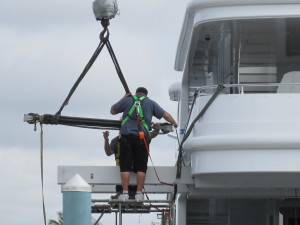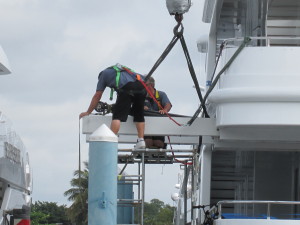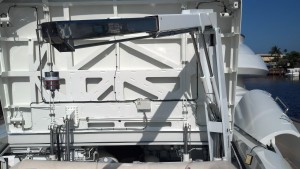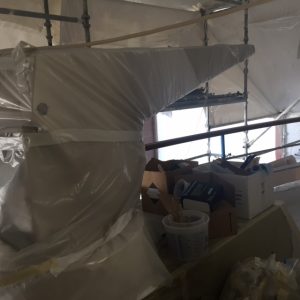 When a 118-foot yacht was hauled out at Lauderdale Marine Center for a full refit including paint, our hydraulics team was called upon to refurbish some of the vessels hydraulic parts including its deck crane and side boarding ladders. After a thorough inspection, we removed the units and rebuilt them to “like new condition.” We stripped the units for paint and replaced all hydraulic hoses, cylinders and hardware. Once the other work is completed on the yacht, we will re-install the side boarding ladders and crane. The “new” side boarding ladders and deck crane will complement the look of the refitted vessel and provide years of service for future voyages.
When a 118-foot yacht was hauled out at Lauderdale Marine Center for a full refit including paint, our hydraulics team was called upon to refurbish some of the vessels hydraulic parts including its deck crane and side boarding ladders. After a thorough inspection, we removed the units and rebuilt them to “like new condition.” We stripped the units for paint and replaced all hydraulic hoses, cylinders and hardware. Once the other work is completed on the yacht, we will re-install the side boarding ladders and crane. The “new” side boarding ladders and deck crane will complement the look of the refitted vessel and provide years of service for future voyages.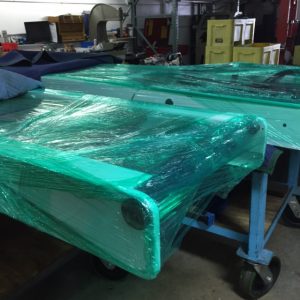
Archive | Cranes and davits
Working on a 26T Crane takes special tools, equipment, coordination and expert experience
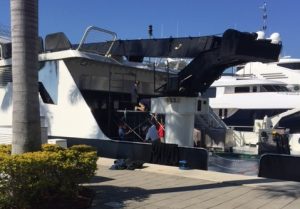
The captain of a 215’ Expedition recently contracted our hydraulics team at High Seas Hydraulics to work on the vessel’s crane. This particular yacht is a shadow boat hired out to “shadow” luxury yachts ferrying extra crews and other “toys” the luxury yacht owners or guest may need on their extended voyages. Those toys can range from large tenders to cars to even a helicopter.
The two luffing cylinders on the crane were leaking hydraulic fluids at the seals and needed resealing before the vessel went out to sea again. The catch on this job was the size of the crane, the weight of the cylinders and the timeline to fix. We had just one week to pull, diagnose, fix and re-install the luffing cylinders on this 26 ton crane, the largest crane we have worked on at High Seas Hydraulics. Each luffing cylinder weighs over a ton and needs special equipment to handle.
Coordination was key to ensure this job went smoothly. We first had to rent scaffolding that needed to be erected on the aft deck in order  for our hydraulic technicians to reach and secure the cylinders for removal from the boat. We then rented a boom truck with a 73 foot reach from a local business to remove the luffing cylinders from the yacht and place on our sister company, Straight Line Marine’s flatbed truck for transportation back to the shop. Having a flatbed truck as part of our fleet comes in handy for these types of jobs as well as moving large shafts from mega yachts.
for our hydraulic technicians to reach and secure the cylinders for removal from the boat. We then rented a boom truck with a 73 foot reach from a local business to remove the luffing cylinders from the yacht and place on our sister company, Straight Line Marine’s flatbed truck for transportation back to the shop. Having a flatbed truck as part of our fleet comes in handy for these types of jobs as well as moving large shafts from mega yachts.
Once back in the shop, we inspected the luffing cylinders and sent them out to be resealed. The company that we contracted to reseal the luffing cylinders was unable to pressure test the luffing cylinders due to equipment problems so they were returned to High Seas Hydraulics. Fortunately, we have the proper equipment and experienced technicians to perform the testing in house for these cylinders that required 2,500 pounds of pressure.
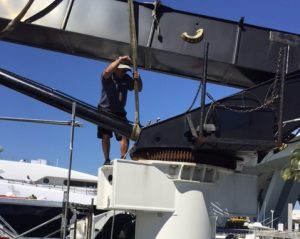
Communications is key
Upon completion of the service work and testing, we returned the luffing cylinders to the yacht using our flatbed, brought the rental boom truck back and re-erected the scaffolding. Here is where the real precision work comes into play. While the boom truck does the heavy lifting, our hydraulic technicians guide the cylinders into place using safety line, straps and chain come-along ratchets. Communications with the crane operator is crucial and is most often done with hand signals.
We first secured the lower end of the cylinders into the crane and pinned them into place while they were still  attached to the boom truck crane. Installing the pin on a crane of this size takes balance and a little brute force! Once in place, we released the straps from the boom truck crane and using straps and the chain come-along ratchets, raised the luffing cylinders into place for securing the top to the crane. We then reattached the hydraulic hoses to the yacht’s crane so we could use the boat’s hydraulic power to extend the luffing
attached to the boom truck crane. Installing the pin on a crane of this size takes balance and a little brute force! Once in place, we released the straps from the boom truck crane and using straps and the chain come-along ratchets, raised the luffing cylinders into place for securing the top to the crane. We then reattached the hydraulic hoses to the yacht’s crane so we could use the boat’s hydraulic power to extend the luffing 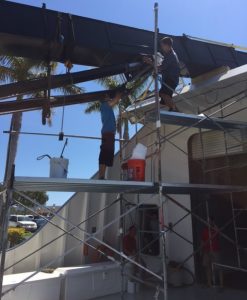 cylinders for the final pin installation. While this work takes experience and knowledge of the process, performing the task while standing on scaffolding more than 10 feet of the deck adds to the complexity.
cylinders for the final pin installation. While this work takes experience and knowledge of the process, performing the task while standing on scaffolding more than 10 feet of the deck adds to the complexity.
Once the luffing cylinders were firmly and securely in place, we re-installed the rest of the hydraulic hoses and tested the crane to ensure that it was working properly for the demanding tasks it undertakes while at sea.
This was a big job with a tight timeline that we were able to push through so the captain could meet his charter schedule. This shadow boat is ready to set sail with those “little extras” that help to make memorable adventures.
Removing Deck Cranes off of a 121’ Heesen
A 1987 121’ Heesen Yacht was recently hauled at Lauderdale Marine Center and both High Seas Yacht Service and High Seas Hydraulics were called upon to bring some life back into this old girl. After 30 years of cruising the oceans, she was in need of some major overhauls on a number of her systems.
One was to remove a couple of old deck cranes from her upper deck which had long since stopped working. Typically when we remove deck cranes for refurbishing, we carefully dismantle the various components to diagnosis the problem and once corrected reinstall the units back in the boat. In this situation, it was deemed that the deck cranes would probably be replaced with new units so we took a more expeditious approach to the removal.
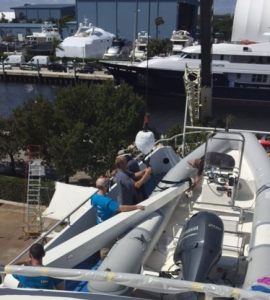
Securing Crane
Our hydraulics team, working closely with the Lauderdale Marine Center ship yard crane operator, methodically attached a number of straps to the units to stabilize them as they worked to release the bolts from the plates that secured the deck cranes to the boat. We are fortunate to have an outstanding crane operator – Angel – that is slow and patient. Constant and clear communications with the ship yard crane operator is crucial to this task and can only come with years of experience working on these types of jobs When you think about the loads these deck cranes are responsible for while hoisting tenders or other equipment more than 30 feet in the air, removing the bolts was no easy task and had to be done with precision to keep the unit from shifting and possibly damaging the yacht.
Once the bolts were close to releasing the crane from the deck, our crew needed to quickly re-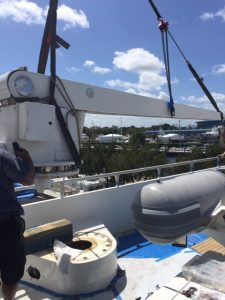 adjust the straps in order to control the unit as it was lifted into the air. Cranes have a very uneven weight distribution and weigh several hundred pounds so without the proper balance applied by the straps and chain come-along, they could twist or slip potentially hitting the deck or the side of the yacht while being lowered to the ground.
adjust the straps in order to control the unit as it was lifted into the air. Cranes have a very uneven weight distribution and weigh several hundred pounds so without the proper balance applied by the straps and chain come-along, they could twist or slip potentially hitting the deck or the side of the yacht while being lowered to the ground.
This type of work takes a lot of experience, knowledge of the units and patience to do it right and to do it safely for both the crew and the vessel.
Performing routine preventive maintenance on Nautical Structures Beam Cranes
We were recently hired to perform routine preventive maintenance on a pair of Nautical Structures beam cranes on a 155 foot Admiral yacht. The beam cranes are used to launch the tender or jet skis that are stowed on the main deck over either side of the boat. They are mounted to the underside of the upper deck and run athwartship, or at right angles to the keel, over the main deck but are hidden in the ceiling.
As part of the process, we removed all four cylinders from the cranes and rebuilt and repainted them in our hydraulics shop along with inspecting all of the bearings. We also replaced the Spectra Line on the cylinders. The four cylinders were located at the top of the beam crane on the port side of the boat. In order to remove the cylinders, we needed to extend the beam crane to pull the cylinders off.
Because of the way the boat was docked, coupled with the fact that it could not be turned around, we could not perform the procedure from the dock. This meant we needed to find a creative solution. Our answer to this problem: rig scaffolding on a floating dock and bring in the yard crane to remove and re-install the cylinders over the water.
When doing this type of work, the safety of our employees is the highest priority. Safety harnesses were used any time the crew was over the water. While this was not the first time we have rebuilt cranes, this was a first in doing so over water.
Performing routing preventive maintenance on Nautical Structures beam cranes is highly recommended after a couple of years of hard use. Finding the right shop that has the technical expertise and creative approach to getting it done will help to ensure trouble-free operations for years to come.
Opacmare Deck Crane Five Year ABS Testing
Depending on the Class of your vessel, your cranes require testing and certification each year or every five years.
It involves careful inspection and load testing by an experienced technician who has kept his training and certification up to the standards required to maintain your vessel’s Class certification.
This Opacmare crane on a 130’ yacht came in for ABS class servicing and testing. The crane used Spectra Line instead of wire. This is not unusual except that due to UV deterioration, any crane that has Spectra Line should consider replacement every 12-18 months.
We replaced the Specta Line, performed load testing of the line and the overall system, re-certified for Class and had him on his way toward another season of safe yachting.
Our technicians have the right certifications to maintain your yacht with the most up to date equipment. Give us a call if you have a question about your crane or simply need new Spectra Line and a re-certification.





